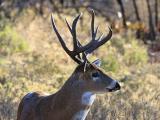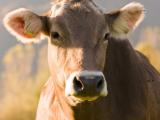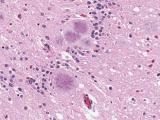Jul 3, 2003 (CIDRAP News) Canada's official report on its response to the mad cow disease case in Alberta suggests that the case might have resulted from the importation of American cattle or contaminated feed into Canada, among other possibilities.
The 12-page report examines the possible causes and implications of the bovine spongiform encephalopathy (BSE), or mad cow disease, case that was discovered in May. The case touched off a massive investigation that led to the slaughter of 2,700 cattle and testing of more than 2,000, without uncovering any other cases.
The report, released yesterday by the Canadian Food Inspection Agency, says the cow most likely contracted BSE from its own mother or by eating contaminated feed. To prevent BSE, Canada and the United States banned the use of ruminant-derived protein in feed for ruminants (cattle, sheep, goats, and other cud-chewing animals) in 1997. But the infected cow was believed to be about 6 years and could have had BSE-contaminated feed before the ban took effect.
About 1.3 million US cattle were imported into Canada in the period "of epidemiologic concern," according to the report. Imports around the time of concern included 25,000 pregnant cows that were moved from US feedlots into western Canada. Most were black Angus, the same breed as the infected cow.
"Although DNA investigations continue, Canada cannot, to date, exclude the possibility that the index case itself derived through this huge, unique importation," the report states.
At the time of the cow's birth, Canada was importing about half of its supply of meat-and-bone meal (MBM) for cattle from the United States, the document says. US-made MBM at the time had the same potential exposures to BSE and related diseases as Canadian MBM did, it adds.
"The possibility of the U.S. being the origin of the index case or the source of contaminated feed remains among the multiple avenues of continuing study, and might be best defined by ongoing surveillance being conducted in the U.S.," the report states. But it also says the cow could have had feed contaminated in Canada by the use of British cattle imported early in the 1990s.
Another possibility, according to the report, is that the cow ate feed containing protein from elk infected with chronic wasting disease (CWD), a transmissible spongiform encephalopathy (TSE) similar to BSE. "As many as 110 CWD-infected elk carcasses might have entered the feed-distribution clusters shared by the prospective herds of origin of the index case during the interval 1993-99," before rendering plants stopped accepting all TSE-susceptible materials, the document says. Investigators were never able to identify the specific herd that the sick cow came from.
The cow also could have contracted BSE through direct exposure to elk or deer infected with CWD, but this is "a lesser possibility" than the feed-exposure route, the report says. It also says investigators considered the possibility that the case developed spontaneously, but this was "ostensibly ruled out on the basis of a molecular genetic evaluation."
In other observations, the report says it is a mystery why Canada's first BSE case showed up in a beef cow, rather than a dairy cow, given that dairy cows were exposed to "exponentially higher volumes" of MBM in the period in question.

















